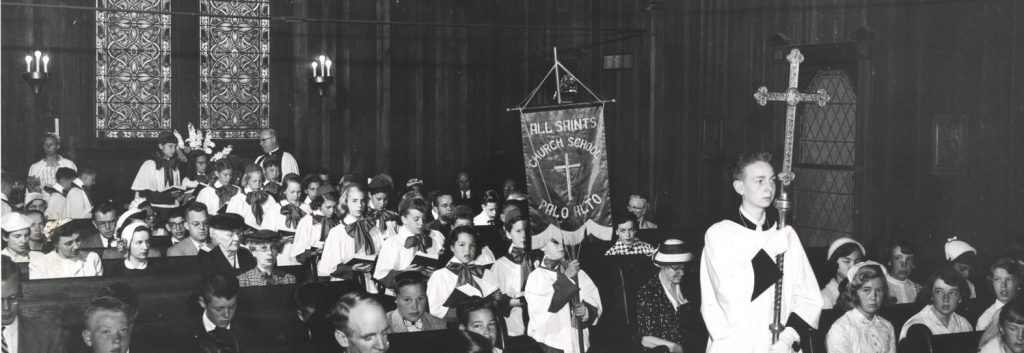
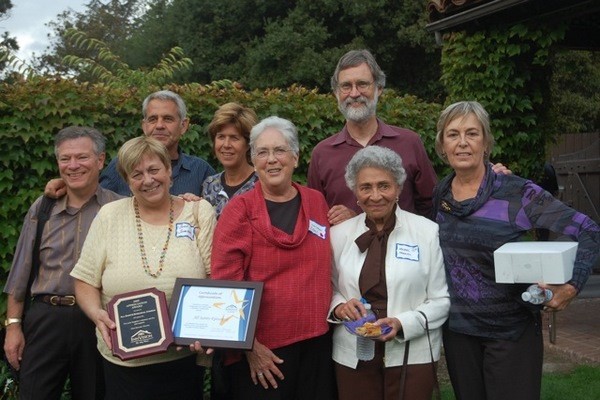
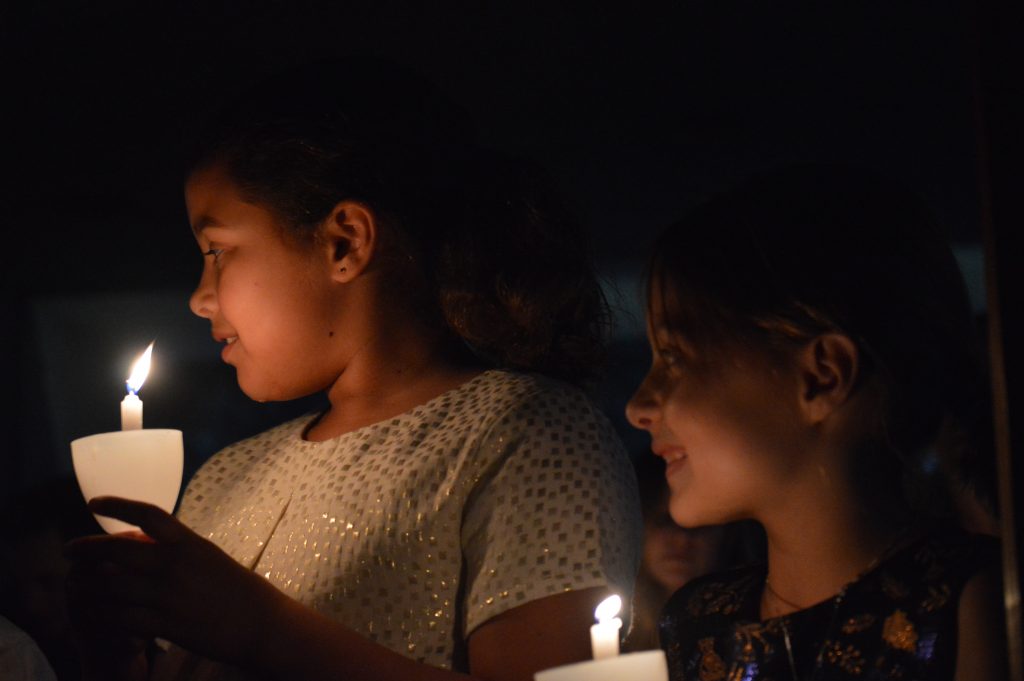
Our building’s history
Dedicated in March of 1968, All Saints Episcopal Church Palo Alto was designed by William Guy Garwood and constructed entirely of poured concrete. The octagonal roof is meant to recall the eight-sides of a baptismal font, while the placement of the altar emphasizes the centrality of the Eucharist in the life of the church.
Although the roof is 1 foot thick, and at the eave line rests on massive projecting beams, it appears to float above the deeply recessed clear glass windows that separate the roof from the walls.
Radiating from a cross in the central lantern, and sloping down to the corners of the building, are four columns of 1” thick stained glass, modulating from lavenders and golds over the altar to mainly deep blues and reds towards the edges.
The custom designed and constructed pews and furniture are all of striped mahogany.
Our parish’s 125th anniversary

In 2017 All Saints Episcopal Church Palo Alto celebrated 125 years of witness and ministry in Palo Alto. On September 20, 1892, a group of about forty lay people gathered in Lirio Hall, just two blocks from our present site, for the first service of what would become All Saints Episcopal Church Palo Alto Mission. Four months later the Mission was formally organized and finally, in April of 1895, the first All Saints Episcopal Church Palo Alto was consecrated. Four years later, in 1899, All Saints Episcopal Church Palo Alto became a parish in its own right. In 1967, the old shingled redwood building gave way to a strikingly modern, poured-concrete structure, now a landmark in downtown Palo Alto.
In 1980 All Saints Episcopal Church Palo Alto opted to join the newly created Diocese of El Camino Real, comprising most of the parishes in Santa Clara County, and all the parishes in Santa Cruz, San Benito, Monterey, and San Luis Obispo Counties.
The following is the Rector’s address at the Anniversary Celebration:
It has probably largely been forgotten, but early in the twentieth century San Francisco was rocked not just by the great earthquake of 1906, but also be a massive graft scandal that involved the business community paying off the Mayor and the Board of Supervisors. In the end it came to almost nothing: the powerful of Nob Hill closed ranks, only one lawyer went to San Quentin, a few people conveniently met with accidental deaths, the DA resigned in frustration and the new one abandoned the case, and so business went on as usual. One quiet casualty, however, was David Evans, the Welsh born, Oxford educated rector of Grace Church, San Francisco. In 1908 he was slated to be the keynote speaker at an ecumenical protest meeting in the Van Ness Theater called the ‘Sabbath of Justice’, demanding civic reform and held the week before the elections, but he was dissuaded from doing so by his Vestry, prominent businessmen with names like McCreery and Deering and Crocker. However, he did send the text of his speech to be read, and within weeks he found himself the rector of All Saints Episcopal Church Palo Alto, Palo Alto. After six increasingly uncomfortable years on Nob Hill, David Evans remained at All Saints Episcopal Church Palo Alto for fifteen years until his retirement; the passion for truth and justice and integrity that had made his ministry untenable there found an abiding home here.
At All Saints Episcopal Church Palo Alto 50th Anniversary in 1942, Bishop Parsons recounted at length some of the history of All Saints Episcopal Church Palo Alto. He knew it better than anyone, because before becoming the 3rd Bishop of California, he had been rector of Holy Trinity, Menlo Park in the late 1890’s, when All Saints Episcopal Church Palo Alto was part of his cure. He personally knew the first priest in charge, Fr Peet, well; he had even sent his young English curate, Charles Gardner, to live and minister here in Palo Alto, a decision that resulted in Dr. Gardner being elected the first rector.
When Bishop Parsons described those first five decades, he referred to a “tradition, carried on in the succession of rectors” of “a spirit quick to the needs of the moment”, “a breadth of vision”, in touch with the “the real and vital things of life, “in sympathy with all kinds of viewpoints”. And as he moved down the list of rectors, he describes each of them in much the same terms – Dr. Parker’s “generous and liberal catholicity”, Dr. Brookman’s “fine catholic tradition”, Dr. Evans’ “wide view of truth and that sensitive concern for truth which had characterized all the previous tradition of the parish.”
And perhaps unusually for a man of his time and position, Bishop Parsons was careful to observe that this tradition was not restricted to the clergy: it may have been their gift to the parish, but unfailingly it was also the parish’s gift to them. Every rector of All Saints Episcopal Church Palo Alto would probably agree that that is as true now as it was in 1942, or in 1892. It is never a question of what gifts someone brings to a leadership position, it’s always a matter of how those gifts are received, how they resonate within the faith community, what they elicit and enable and empower. One of the foundational lessons of Bethlehem is surely that the presence and identity of God is made manifest not simply in the bestowing but rather in the exchange of gifts.
Diarmaid McCulloch’s book, “Silence: A Christian History”, warns us that the study of history must consider not only what has been written and recorded, but also what is not being said, what is presumed, or passed over, or edited out. As mention of 1942 immediately recalls, that fiftieth anniversary occurred while the world was at war, just as the twenty-fifth anniversary fell when another world war was dragging to an agonizing close. How many people sat here on this property celebrating those occasions while they were their minds and hearts were on the other side of the world, grieving, worrying, fearing, hoping. The quick turnover of early rectors almost assumes the reader knows that, of course, tuberculosis was rampant and was taking a heavy toll. And in every decade, there have been the reliably regular crises within the national church, the diocesan disputes, the parish psychodramas, to say nothing of the strides and setbacks in civil rights, the political scandals and betrayals and heartbreaks …… Always the story of faith, of prophetic witness, the insistent demand for equality, for freedom, for justice, for honesty, for compassion – always this is played out against a backdrop of conflict and of suffering. Understandably we don’t dwell on unpleasantness, we seldom choose to speak of it except in hushed whispers, but it too is part of our story, it has made us define our identity, and order our values, and find our voices. It takes time and wisdom to be thankful for pain, but here we know that that too has made us who we are, and has been filled with grace.
From the very start it has been universally acknowledged that this parish came into existence because of one woman, Mrs. Willard, who organized the first service in her school, Lirio Hall, a few blocks along Waverley Street, and that is has been sustained at every stage of its life by some other seriously formidable women like Lydia Mitchell who was there for that first service and was still there fifty years later, Elizabeth Gamble, Dorothy Beckett, Patsie McAfee. While it may have been the eminent men of the vestry who decided in 1904 or so that the church needed a bell tower, it was the Women’s Guild who paid for it; when the gentlemen authorized the purchase of the parish’s first organ in 1906, the Guild footed the bill, and so laid the foundation of that musical tradition which still flourishes here.
Parish histories can easily become self-congratulatory: ours, instead, is powerfully reassuring. As at every stage in our past, we are still striving to create households where integrity and justice and honesty and generosity and fidelity are nurtured and protected for another generation, where parents and grandparents teach their children the crucial importance of telling the truth, of respecting the dignity of every human being, of acting justly and compassionately. Not that long ago it was possible to believe that what we have been speaking about and treasuring and nurturing here and in places like this, year in, year out, was by now largely taken for granted, that it had morphed into more or less universal human values, that our values were now the currency of government and the ideals of industry. But now we see every day just how precarious our hold on goodness really is, how vital our presence and witness have become to the health and sanity of our society.
The very fabric of our community relies on faithful, generous love, on people who forgive and apologize and ask forgiveness, people committed to speaking and listening to the truth, people who are patient and generous and encouraging with one another, and who create spaces where honorable behavior is a reasonable, predictable expectation. And curiously, who we are striving to become is what we have always been. And in that lies our hope.
Our Organs
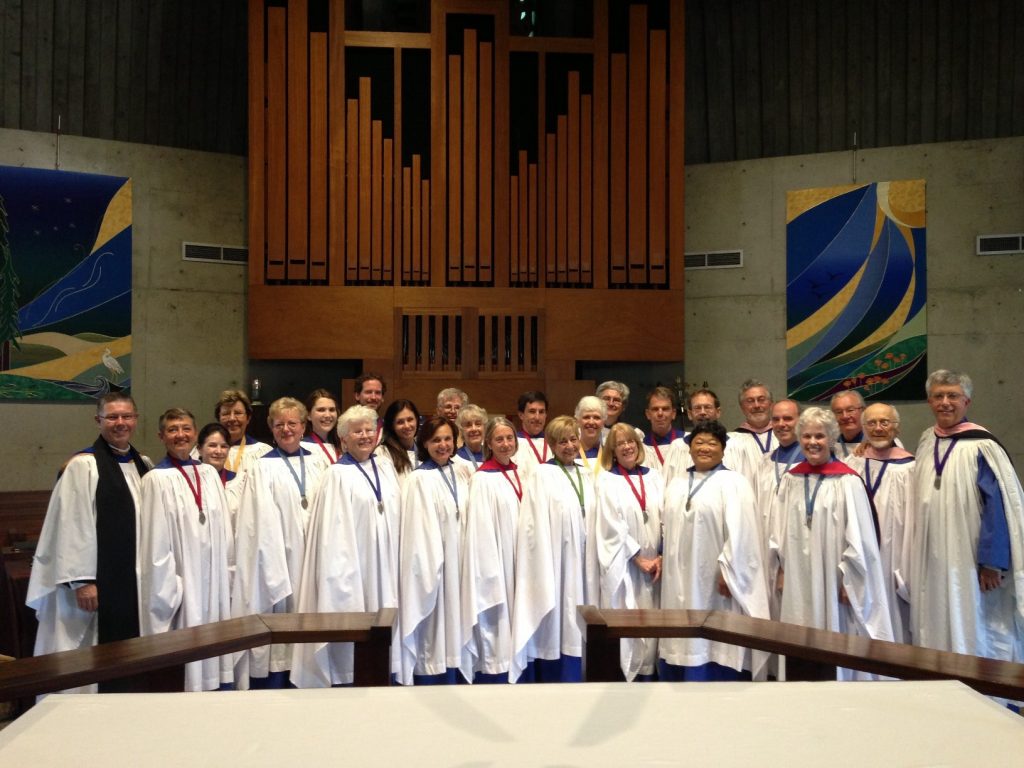
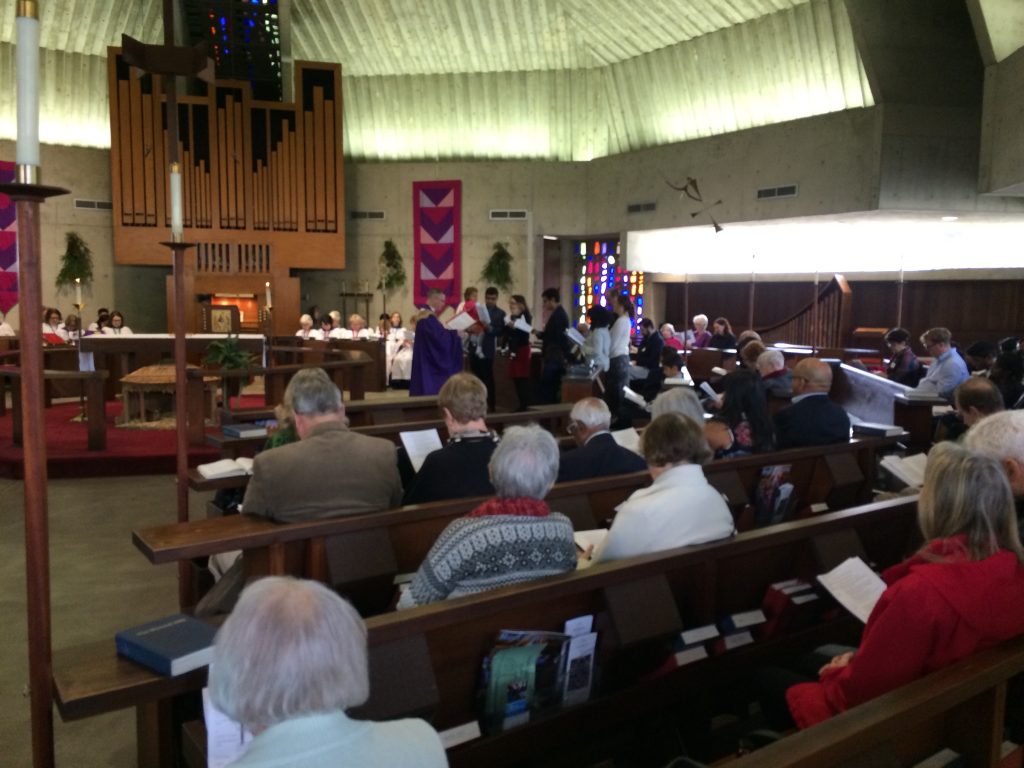
All Saints Episcopal Church Palo Alto is very proud of its two pipe organs, both built at the time of the new church construction in the late 1960’s by Flentrop Organbuilders of Zaandam, Holland. The parish’s decision to engage Flentrop was certainly influenced by the company’s most monumental organ in the United States at the time, the four-manual instrument in St. Mark’s Episcopal Cathedral, Seattle (1965).
These mechanical-action instruments were considered radical at the time: most Episcopal churches favored the “traditional” American Classic electro-pneumatic organs of, especially, Aeolian-Skinner, who placed significant organs in virtually every major church and cathedral in the United States, including Grace Cathedral, San Francisco (All Saints Episcopal Church Palo Alto mother church until the new Diocese of El Camino was formed in 1980).
The small one-manual positive organ was placed in the church while Flentrop completed the larger main instrument, which arrived some two years later. Both have been crucial in fostering the exceptional congregational singing which All Saints Episcopal Church Palo Alto is famous for. The direct projection into the room of the organ’s sound – traditional in singing denominations in Europe and the U.S. for centuries until the late 19th and early 20th centuries – allows for effortless leading of the singing with relatively few stops.
As for organ literature (preludes and postludes and such), while the large organ is happiest playing the music of J.S. Bach and his contemporaries and predecessors, a wide range of music is heard on Sundays and festivals. The warm sounds work for Bach and Brahms, Buxtehude and Mendelssohn. The live acoustics of our worship space enhance the sounds of the organs and of all the music.
We look forward to meeting you at one of our services!